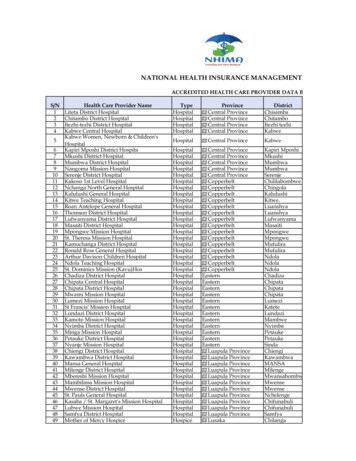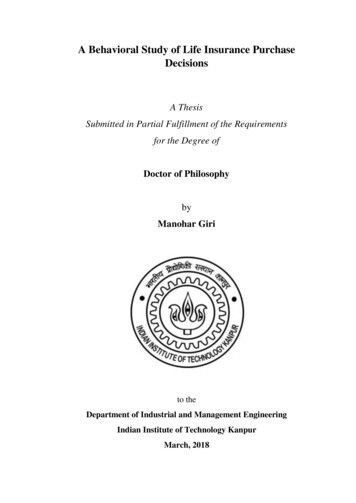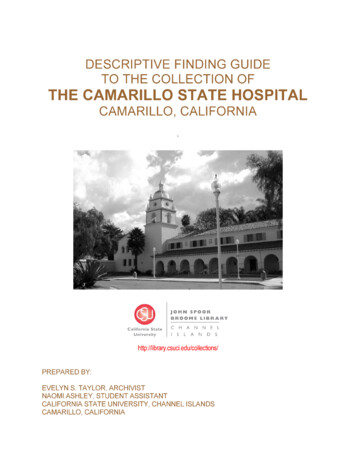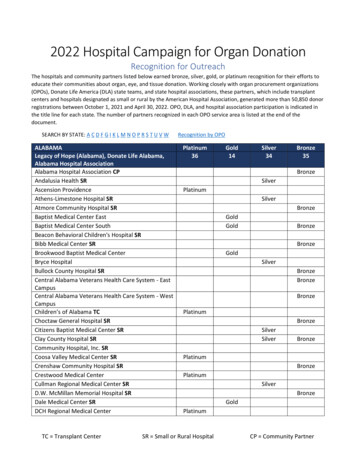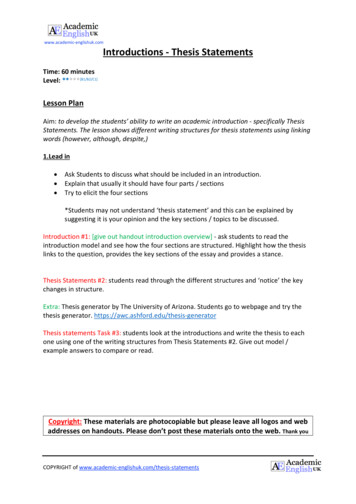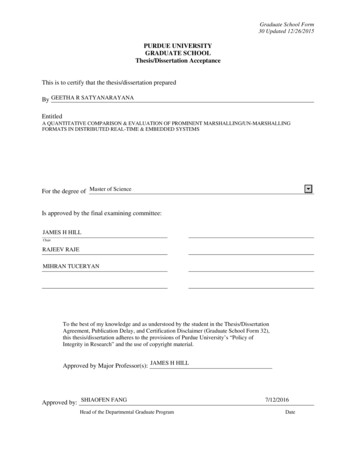
Transcription
Thesis Program:A GENERAL HOSPITAL FOR SEMINOLE
TABLE OF CONTENTSForward Present ConditionsHospital HistoryHospital DepartmentsAdministrationPageI 1 . 5 88General Business Office10Medical Records12General Public13Diagnostic and TreatmentGeneral Laboratory15Radiology1?Physical Therapy19Pharmacy21Patient Care23The Patients23Nursing.3.1Nursery. 3 Obstetrics36Surgical38Intensive Care1;1Service DepartmentsCentral S t e r i l e Supply.1 2Emergencylili
Dietary FacilitiesPagek General Supply1*7Housekeeping of Laundryk7Maintenance of Mechanical EquipmentkQSite50Budget53Appendix A (Community Statistics)Appendix B (Hospital Distrubution and Statistics). . .
ForewardOn April 29, 1971, an act authorizing the creation of the SeminoleHospital District of Gaines County, Texas became a reality.The districtcreated by this act is charged with the responsibility of establishinga hospital or a hospital system within its boundaries to furnishhospital and medical care to the residents of the district.With this bill enacted, the board of directors has asked thatthe feasability of new medical facilities for the area be studied andaction taken on the recommendations.
RESENTHo
Present ConditionsGaines County is located on the South Plains of Texas and is onthe border with New jyfexico. The county itself is relatively young,being created from the Bexar District in I876 and organized in 1905.The major economy prior to the 1930's was devoted to ranching butsince then the economy has changed to oil and farming.Tha annualsale of oil and its by-products is estimated to exceed 86,000,000a year while the farms have an estimated yearly gross of around 30,000,000.Population, as well as economic indices, seem to show a moderatebut steady increase during the sixties, although it should be notedthat preliminary census returns for Gaines County show a decrease inthe county's population.The school census shows a peak in I96I4-65school year and has declined slightly each year since then.At the present time there are actually three hospitals servingthe population of Gaines County.There \s the Seminole MemorialHospital, which is a licensed 28-bed, 22-room faciJity.22 beds conform to state standards.a 17-bed licensed facility.standards.In this facilityThe Seagraves Hospital Clinic isTwo out of the 17 beds conformed to stateAlso directly North of the county line is the Denver CityHospital whose trade areg extends into Gaines County.But the GainesCounty facilities also tend to draw people from the Denver City areaand therefore it can be assumed that the loss and gain of people inthe county would be offset and the medical facilities should be planned1
for the total population of Gaines County.(See composite patientdistribution table).The community of Seminole also contains one l6-room, 32-bednursing home which draws patients from an area of several counties.Outpatient services are conducted in separate facilities near thepresent hospital in Seminole, and there are presently two medicaldoctors and one dentist in Seminole and one medical doctor and onedentist in Seagraves.It is also hoped that new facilities would helphold these people in the community and also attract more generalpractitioners.The county has recently put into service a county-wide ambulanceservice which is run by the sheriff department.There is one unitstationed in Seminole and one unit in Seagraves.Another new program has also been recently started in conjunctionwith State Hospital in Big Spring.This facility is located in avacated doctor's office adjacent to the Seminole Hospital.Seagraves Clinic HospitalThis is a short term, acute, general medical and surgical hospitalwith 17 beds.The supporting service includes laboratory, x-ray,surgical, delivery, inhalation therapy and emergency.Adjacent to andconnected to the hospital is a suite of offices and examining rooms forthe doctor's use in seeing outpatients.The land and building areMcCollough, M. D.owned by the county and leased to BillThe building itself was constructed in several stagesand covers the majority of the site.It is one story with stucco ex-terior walls and plaster interior partitions.The age and characterof the structure does not lend itself to further expansion. A few f
deficiencies include the use of hsillow core doors and failure to meetthe minimum standards of the Texas State Department of Health LicensingDivision in the corridors of the patient wings.(For hospital statisticaldata see Appendix B ) .Memorial Hospital - SeminoleThis is a short term, acute, general medical and surgical hospitallicensed for 28 beds, but for space reasons, should be considered a 22bed hospital.Supporting facilities include laboratory, x-ray, pharmacy,dental surgical, surgery, delivery, and emergency.The building and land are owned by the county and operated by anappointed hospital board.The present facilities were constructed in1952 and 1953 with the formal opening being on April 11, 195U.Therewere three doctors with two examination rooms in the facility at first,but this section was remedied in the early sixties.The space wasused for the expansion of the pharmacy, bookkeeping area, and smallchapel.Also with the doctor's suites being moved into separate facilities,a portion of the large waiting area was converted into administrativefunctions,/The building itself is a one-story structure with masonary exteriorWalls and masonary and plaster interior partitions.This hospital isconsidered the best of the present Gaines Coimty Health Facilities.(For statistical data see Appendix A ) .ConclusionsIt is felt that in the best interest of the citizens of GainesCounty, a single hospital facility located in ' ' nipole nould offer thebest health care for the district.The single facility would eliminateduplication of hnildings, equimient, supplies, and SDnce.By locat'r--
the facility in Seminole, which is near the geographical center of thecounty, a convenient location for the majority of people in the countyis also achieved.Also one new and modern health facility could provequite attractive in helping to bring new doctors into the area.The size of the hospital cannot be determined by any universalformula, but several methods will give a general level in which towork:(l) By combining the total number of licensed beds presently inthe county there would be a total of ii7 beds (28 beds in Seminole plus19 beds in Seagraves), (2) By using the recommendations published bythe "State Plan" (which includes a use factor) there should be a totalof 50 beds, (3) By using the formula four beds per thousand population,there would be k times 12 (11,575--preliminary count of populationfor Gaines County in 1970), or J48 beds.From these calculations, itwould seem that planning should occur within the range of i;8 to beds with consideration given to future population and standards x-rhichmust be conformed to.
OSPITALO2
HOSPITAL HISTORYAs the name hospital suggests, the hospital began as a placein which a commimity discharged its responsibility for offeringhospitality to passing strangers.The most primitive form of the hospital may have been the cavein which early man gave refuge to a companion in despair.The earliestknown religions included certain ceremonies closely associated withhealing, and some religious leaders doubled as doctors. Medical treatment was identified as part of organized religions as early as UOOO B.C.Among the earliest organized hospitals were those in Greece,Egypt, and India during the pre-Christian era. Greek temples, as earlyas 113ii B. C , served as resting places for patients under observationand treatment constituting what may have been the first medical schools.Considerable impetus was given to organized medicine by the teachingsand practices of the Greek physician, Hippocrates, b o m about 1 60 B. C.Even though forms of the hospital existed prior to Christ, creditfor the alleviation of suffering on a widespread basis must be given toChristianity.The early Christians looked upon the hospital as a re-fuge for travelers and victims of disaster. Romans who had been wonto Christianity established hospitals for lepers, cripples, the blind,and the sick poor during the fourth century A, D.Under the influence of Emperor Charlemagne, many hospitals wereestablished in the Holy Roman Empire, and it was common to find hospitals
adjacent to monasteries so that nuns and priests could conveniently carefor the sick.The first nursing order is considered to have been theSt. Augustine Nuns, organized about 1155.Before it was transplanted to this continent, the hospital had become a place where the community discharged another responsibility: tocare for those of its members who were unable to care for themselves.A rapid increase in the size of communities brought about the separationof comnnmity members needing care into specialized institutions, and bythe turn of the century, the city hospital in this country had become aplace where the critically ill and the dying poor were cared for.Inless densily populated areas all categories of the materially resourceless were placed in "poor farms" unless they were able to work, in whichcase the responsibility of caring for them was contracted out to thehighest bidder, under a system which was an outgrowth of the Elizabethanpoor law.Traces of this practice persisted into the 1920's.During the last quarter of the nineteenth century, the Elizabethanstyle of assuming the responsibility for those of the poor and otherwisehandicapped, has been replaced by a system of custodial care designedto protect persons in these categories from exploitation.Until relatively recently, custodial care was considered dishonorable, but it is now thought of as "not good enough" and the word "custodial" has been stigmatized.At the turn of the present century, thehospital was a place where poor people died, and the role of the hospitalpatient was intended for persons who were dn critical condition and hadbecome financial burdens to society. The majority of the doctor'spatients were simply treated in their own home and unless they werecritically ill, would not go to the hospital.During the present century, the status of the hospital has changed
from a place where poor people died to a place where most people arenow b o m , are subject to elaborate checkups, are treated for certaindiseases, undergo surgery, and eventually may die.The hospital has become an integral part of today's m o d e m society.Within the next few years virtually every American will be covered bysome form of health insurance sponsored by the Federal Government andpaid for by greatly increased Social Security contributions.Today there is a constant change in hospitals due to both newtechnological developments as well as new treatment techniques. Withinrecent years, the layout of nursing units have evolved through circles,triangles, and race track corridors. Trends tend to be toward singlerooms, isolation rooms, hyperbasic facilities, cardiac units andphysical facilities which are designed more for prevention and not cure.It is felt that the care of people with chronic degenerative illnesseswill fall upon the hospital services within the next 20 years.Because of the extremely rapid evolution in hospital technologies,not only the hardware, lighting, air supply, operating room equipment,but also the very nature and arrangement of spaces required the hospitalcan easily become obsolescent. Flexibility is not the pat answer forthese problems, but it is a basic part.
CO
HOSPITAL DEPARTMENTSThe chief objective of the hospital is, of course, to provideadequate care and treatment to its patients. Yet, no other buildingcontains such a range of functions, each with special space andequipment requirements interrelated and connected by intricate websof traffic patterns and networks of mechanical and communicationsystems. Each function is likely to grow and change at a differentrate and independent of all other functions.Therefore, there mustbe a constant thought on flexibility.Additional objectives which the hospital strives to achieveare such things as easy and adequate maintenance, organizational stabilityand growth, financial solvency, medical and nursing education, andvarious employee-related objectives.It has been the objective of thehospital within the past few years to operate as effectively and economically as possible but this is not necessarily compatible with thehospital's tradition of a humanistic orientation and the objective ofthe best service to the patient.The best way is not always the mosteconomical way.Admini str at ionThe hospital administration is an essential part of the hospitaloperation.It reflects more sensitively and directly the character andorganization of the hospital as a whole. The hospital administrator isthe person who oversees the whole process. As chief executive officer.8
'. WF '.'A;;".!!!-the administrator, is responsible to the board of directors for carryingout established policies and for all nonmedical activities carried onin the hospital.Board meetings are held once each month, with thepossibility of an emergency meeting anytime.The attendance at thismeeting consists of six board members, the administrator and assistantadministrator plus two people from the press and possibly the doctors.The activities range from discussion of current problems with an expertto watching films or slide shows and regular reports of the hospitaloperation.The administrators' chief responsibilities are as follows:(A) torun the hospital as an institution—a place where lodging and a broadnumber of technical services are provided for the sick (hire, direct anddismiss personnel on the hospital payroll).He is responsible for thequality of work and in charge of housekeeping and the upkeep of thephysical plant. When needed, he enforces rules and regulations whichgovern the hospital and its relationships with patients. (B) to representthe Board and ultimately the community in the effort to get the bestavailable medical care for every patient.(C) to represent the hospitalin its relations with the community, sharing this function with the Boardof Directors.Much of the administrators' time is spent behind a desk doing paperwork and talking or counseling with employees about various problems.He uses a dictating and an adding machine frequently in his work.Through-out the day he must be available to talk with the general public, be ita salesman, an individual or a couple, somtimes in privacy.The adminis-trator must put forward a feeling of good public relations.There isnow instilled in the community a very friendly informal type atmospherebecause, as a general rule, most people know each other.The administrator
10must also work in close conjunction with the business office if a problemarises.He must also keep up with the latest developments in hospitals and hospital systems.To do this, he must have easy access to many booksand periodicals on the subject, such as his private files. He will needtwo filing cabinets and one bookcase for storage of his private researchinformation.The Assistant Administrator shares many of the organizational responsibilities with the administrator and is capable of filling in forthe administrator if need be.The main responsibilities of the assistantadministrator lie in personnel and accounts receivable.Much of histime is spent in conjunction with bookkeeping and in visiting the varioushospital departments and helping them with any problems. He also usesa dictating and an adding machine frequently and must be able to discussa problem or causes of action with an employee in private.The assistantadministrator must have easy access to the personnel files.A secretaiy is needed to assist the administrator and handle correspondence work.She will also make appointments if necessary, to see theadministrator, and take all calls for the administrator.If there arepeople waiting to see the administrator, it is the secretary's job tosee that they are seated and comfortable.It is not expected that overthree people will ever be waiting at one time. The secretary will dotyping from both dictating machines and manuscript.She may also do somebookkeeping work from time to time.The general business office is included within the administration.There will be three secretaries in this branch.One secretary will bemainly responsible for posting the patient ledger, one for insurance andone for admitting and dismissing patients.All secretaries will be typingand must have access to an adding machine.These secretaries will also
11receive and sort mail. There will be one person who will operate a PBXswitchboard. Her main function will be to operate the switchboard butshe will also be able to type or carry on other functions in the generaloffice.She will also have access to a cardex or listing of patientnames and room numbers and thus serve as the source of information forthe waiting public.The admitting and dismissing secretary will gather information froma patient's friends or relatives. In admitting, there may be two peoplewho admit a patient, for example, parents admitting a child. If noprevious information is available in the hospital on the patient, admitting may take as long as thirty minutes. If information is availablefrom a previous admittance, the secretary will confirm and transfer theinfoimation from the medical records which she has access to. She willtype this information on standard forms. The patient, when possible orrelatives, must sign the admitting form,if the secretary is talkingwith the patient, she will take any valuables or drugs from the person,place them in an envelope and put the envelope in a small vault or safewhere other important records and docimients are kept.In dismissing a patient, the secretary will return the personalpossessions and receive payment or confirm billing information from thepatient.The patient or relatives,usually not more than two people at onetime, may also need to coimsel with the insurance secretary or give information to her. This secretary will usually type the information on a formas it is given, and in most instances a signature will be required on theform itself.It will be necessary that this department hire two future employees
TPT""-" 12to ease an overload on the admitting and insurance secretary when theworkload becomes greater.Also, a posting machine for the daily postingof patients' ledgers will be put into operation and run by the postingsecretary.The medical records department forms a most important link betweenpatient care and administration.The medical record, also called thechart, is initiated upon admission of the patient by typing on a facesheet his name, address, and other personal information.The face sheetis placed in a folder, and to it are added thereafter notations and explanations of everything that is done for the patient:all diagnosticprocedures such as Xray, laboratory tests, physical examinations; alldiagnostic findings such as temperatures, pulse and other measures of thepatient's condition; all treatment in Xray, physical therapy, surgery.Casts, splints, special diets, medication given; all findings of thedoctor, including the autopsy record in the case of death; the date ofdischarge; all charges and payments and doctor's orders. The recordthus grows with each entry. During the time the patient is in the hospital,his record is kept at the nursing station in the patient care divisions,usually in a temporary metal cover identified on the outside with thePatient's name and room number.The record must be kept readily availablefor making entries and for reference each time the doctor visits thepatient; yet it must be protected from general observation because of theconfidential information it contains. The patient is seldom permittedto see his record.After the patient is discharged, the record is removed from the cover,all entries are completed and closed and the record is taken to the recordlibrarian.The record librarian will help in the closing of some entries.She will discard some duplicate items.If the patient reenters the hospital,
13she will take his old record from the file and it will start accumulatingdata again. Records are stored for ten years, three of which they arekept in the current file in four filing cabinets, which the librarianmust have easy access to.In addition to helping with closing entries 7 typing, dictating, or transcribing, the librarian must sort and stackthe records coming out of and entering the inactive files. The recordsare usually relatively thin and usually eight to ten of them can bestacked in a one-inch thickness. The overall size is ' x 11".The record librarian must also be in charge of the medical periodicalsin the hospital. The periodicals are used by the administrators anddoctors.The doctors usually come here to relax, dictate informationor work on reports when they have time. Many times a doctor wi esto sleep for a few hours while waiting for an 0. B. case or other developments. At other times doctors may read, research or discuss developmentsin a case with other physicians or the admGinistrator.The General PublicThe public will come to the hospital for three general reasons:(1) to be admitted as a patient, (2) to visit a patient, (3) to seespecifically an administrator.The majority of people who come to thehospital arrive in cars.Since the visiting hours of the hospital are not specifically set—the doctor decides when the patient can or cannot have visitors--therewill never be many people waiting to see a patient.Most people willsimply check with information about the room number, and then continueto the patient's facilities. There should not be over 15 people waitingto see patients.A person coming to the hospital to be admitted will probably come
Hiwith a friend or relatives. He will either go through the admissionprocess hitnself, go directly to the patient facilities upon entry, orbe attended to for severe injury or sickness in the emergency room, andthen be taken to the patient facilities. In the latter two cases thefriend or relatives will go through the admission secretary and theadmittee should be conducted in a semi-private atmosphere because someinformation will be confidential. There may be a slight delay if thesecretary is already busy but if the insurance secretary is not busy,she should be able to handle admissions also. There should not be overtwo parties waiting to be admitted at one time. This is also true forthe insurance.The people o must wait occupy their time by reading magazines ornewspapers or visiting id.th one another. They will have at theirconvenience five vending machines which will provide soft drinks, coffee,sandwiches, candy and cigarettes. These machines will be checked andsupplied by the Women's Auxiliary i o also maintain a small gift shop. Thegift shop handles two daily newspapers, two weekly and four monthly magazines. A small selection of cards (20 types on display); four small giftsets, several small toileture items. It is the Women's Auxiliary's jobto store the vending machine supplies and keep an inventory of itemssold. The shop is opened three hours in the morning and three hours inthe aftemoon during the fall, winter, and spring. During the summerthe Candy Stripers man the shop from 9:00 a.m. until 6:00 in the evening.A cash box is used to hold the money used in the transactions.The general waiting public will have access to toilets, one formen and one for women (two fixtures in each). These are used primarilyfor the convenience of the public. The administrative employees willhave access to private toilets. Some people may wish to make telephone
15calls out of the hospital.Many times these calls are private.Itis expectc dcth at not over two or three people will be calling atthe same time and just two public phones should be provided.A family may from time to time want to be isolated from thegeneral busiaess of the waiting public. They may have a relative orfriend in surgery or recovery and wish to have a quiet atmosphere in whichto meditate or pray while waiting to here of the patients condition.The time spent in isolation from the public may be one or two hours,depending upon the patients condition.The family, after hearing ofthe condition, may either stay, if death has occurred, be permitted tosee the patient, go home, or return to public waiting to relax, reada magazine or just sit.Diagnostic and Treatment FacilitiesA significant part of patient care is given by adjunct diagnosticand treatment services.All of these are secondary in that they aid thephysician in diagnosis and treatment, are given only upon the physiciansprescription, or perhaps routinely as a standing order.In most instancesthe patient goes to the department for the test or treatment but in somecases such as some physical therapy, (BMR), the test or treatment can bedone at the patient's bedside.The General Laboratory is where numerous types of testing anddiagnosing takes place. There are two main divisions in testing, thechemical analysis and the microscopic analysis'.There will be three people working within the confines of thegeneral laboratory but one technician will also help in the radiologydepartment.The testing will include chemistries, bacteriology,serology, and hem tology.Although much of the testing can be done with
16a duplication of equipment each of the procedures must be briefly explained .Hematology is connected with the count of red and white corpusclesand with blood chemistries. Employee's in the laboratory have indicatedthat this field represents about seventy-five percent of the analysis donein the laboratory.One person and only one person will work the testall the way through to ensure that no samples are mixed and that eachsample is done with the correct procedure. Blood samples are usuallydrawn from the patient, by a lab technician just before they are givenbreakfast. The blood, which is usually in marked test tubes is thenbrought to the laboratory in a hand carried "basket."Once in the labthe work begins. A quantity of blood is taken from the test tube andmixed with different chemicals, depending on the nature of the test.The test may then be placed in a centrifuge to separate the variousproperties. After the basic blood characteristics can be studied undera microscope, t h e findings are then written down in duplicate with onereport going into the patients chart and the second being filed in thelaboratory storage. The emergency blood bank should be readily availablefor blood matching, and must be kept in refrigerated facilities. Theblood chemistries require more equipment such as a sink and a fume hoodand up to 20" of counter space should be allowed for this work andequipment. There should be two microscopes for the laboratory.The bacteriological work is almost wholly microscopic. The culturesare grown in petri plates in an incubated atmosphere. The culturesmay take from one day to several weeks to grow and there may be as manyas four dozen cultivating at one time. After the cultures have beenexamined the petri plate and the culture are placed in an auto-cleve,which through heat and pressure, kills all bacteria - The remains can
17then be placed in a regular waste recepticle. This procedure is alsocarried through by one person who will make a duplicate report afterthe analysis.Chemical analysis of urine, sputum, feces, mucous and other bodyelements are also done with the blood chemistries. Most of these elementsare picked up at the nursing facilities in the early morning. All glassware (test tubes, slides, petri glasses) are washed in the lab and driedin a small oven.Many times patients are brought by wheelchair, stretcher, or onfoot from the patient care facilities to the lab technician at which timethey might be asked for a urine sample, to give blood, to t e an EKG,a BMR, or an encephalograph (EBG).The EEG requires the insertion ofelectrodes into the skull and sensitive instruments for the measuringof microscopic currents.Because of this all outside electrical inter-ference must be screened.Patients are usually in a reclining positionwhen these tests are made and clean linens are required for each patient.There will be only one patient handled at a time by the technicianand proper scheduling should adLeviate the majority of patients waitingbut on b u days or in emergency instances there might be a slight delayof five or ten minutes and never more than two patients waiting.The technician besides diagnosing and analyzing must also seesalesmen and do paper work such as statistics and scheduling.Techniciansdo not like to talk with salesmen while testing because of the complexityof the work and the time involved, sometimes one or two hours, oncetesting has started.As was said earlier when a person starts a testhe usually must finish it.The Radiology Departments primary function is to take shadow picturesof vital parts of the human body.This process requires costly equipment
18which is permanently fixed in place and all activity must occur around theequipment.This department handles all states of sick patients fromemergency patients with superficial and internal injuries, to completelyor partially paralyzed, to amblatory patients.They will arrive onstretchers, wheel chairs and on foot and there may be a slight delay(never more than two patients) before entering the facilities. But,patients usually come by appointment for a prescribed number of picturesand the length of stay can be determined to give maximum utilization ofequipment with minimum waiting.The load on the radiology department issoon expected to justify the use of two Radiographic-Fluor scopic units.This equipment must be screened by lead from the other parts of thehospital.Each unit will include a tilt table, rotating table andbuckey reciprocatin
stationed in Seminole and one unit in Seagraves. Another new program has also been recently started in conjunction with State Hospital in Big Spring. This facility is located in a vacated doctor's office adjacent to the Seminole Hospital. Seagraves Clinic Hospital This is a short term, acute, general medical and surgical hospital with 17 beds.


